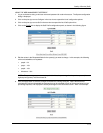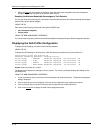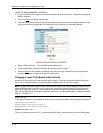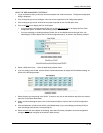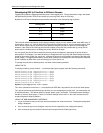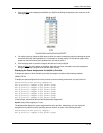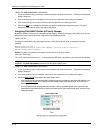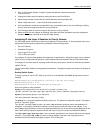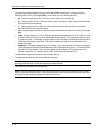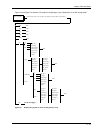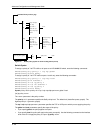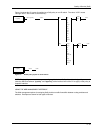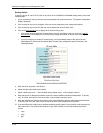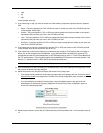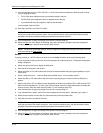
Quality of Service (QoS)
4. Enter or edit the MAC address, if needed. Specify the address in the following format:
xx-xx-xx-xx-xx-xx.
5. Change the VLAN number if needed by editing the value in the VLAN ID field.
6. Select the port number from the Slot (for Chassis devices) and Port pulldown lists.
7. Select a QoS level from 0 – 7 from the QoS field’s pulldown menu.
8. Click the Add button (to add a new static MAC entry) or the Modify button (if you are modifying an existing
entry) to save the change to the device’s running-config file.
9. Click the Apply button to save the change to the device’s running-config file.
10. Select the Save
link at the bottom of the dialog, then select Yes when prompted to save the configuration
change to the startup-config file on the device’s flash memory.
Assigning IP and Layer 4 Sessions to Priority Queues
You can assign specific traffic flows to queues by configuring IP access policies. IP access policies allow you to
assign flows to priority queues based on any combination of the following criteria:
• Source IP address
• Destination IP address
• Layer 4 type (TCP or UDP)
• TCP or UDP port number
You configure IP access policies globally, then apply them to specific ports. QoS policies apply only to outbound
traffic, so you must apply the QoS polices to a port’s outbound direction instead of the port’s inbound direction.
To configure an IP access policy for assigning a traffic flow to a priority queue, use either of the following methods.
USING THE CLI
The CLI syntax differs between routing switches and switches. Examples and syntax are shown for both types of
devices.
Routing Switch Syntax
To assign a priority of 4 to all HTTP traffic on port 3/12 on an HP 9304M or HP 9308M routing switch, enter the
following:
HP9300(config)# ip access-policy 1 priority 4 any any tcp eq http
HP9300(config)# int e 3/12
HP9300(config-if-3/12)# ip access-policy-group out 1
Here is the syntax for routing switches.
Syntax: [no] ip access-policy <num> priority <0-7> <ip-addr> <ip-mask> | any
<ip-addr> <ip-mask> | any icmp | igmp | igrp | ospf | tcp | udp | <num> [<operator> [<tcp/udp-port-num>]]
Syntax: ip access-policy-group in | out <policy-list>
The <num> parameter is the policy number.
The priority <0-7> parameter specifies the QoS priority level. The default is 0 (best effort, qosp0). The highest
priority is 7 (premium, qosp3).
The <ip-addr> <ip-mask> | any <ip-addr> <ip-mask> | any parameters specify the source and destination IP
addresses. If you specify a particular IP address, you also need to specify the mask for that address. If you
specify any to apply the policy to all source or destination addresses, you do not need to specify any again for the
mask. Make sure you specify a separate address and mask or any for the source and destination address.
The icmp | igmp | igrp | ospf | tcp | udp | <num> parameter specifies the Layer 4 port to which you are applying
the policy. If you specify tcp or udp, you also can use the optional <operator> and <tcp/udp-port-num>
parameters to fine-tune the policy to apply to specific TCP or UDP ports.
2 - 17



